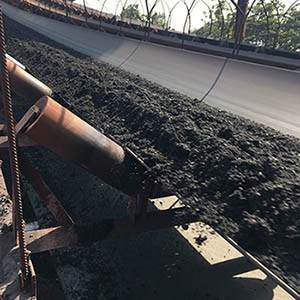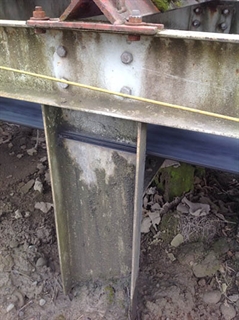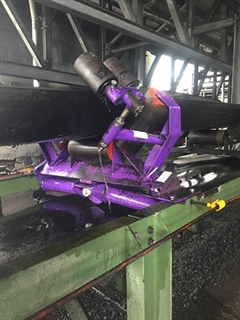How To Keep Your Conveyor Belt on Track
 When your operation is working at full speed, trying to move product or fulfill orders, the last thing you need to worry about is your belt mistracking. Unfortunately, sometimes even the slightest movement or change in the conveyor can throw your belt off track. Misalignment of rollers or pulleys, an incorrect splice, and material build-up are just a few things that can get your belt off track. Sometimes a slight bump by heavy machinery or even the weather – high winds, frost, and even sunshine – can interrupt your belt’s path.
When your operation is working at full speed, trying to move product or fulfill orders, the last thing you need to worry about is your belt mistracking. Unfortunately, sometimes even the slightest movement or change in the conveyor can throw your belt off track. Misalignment of rollers or pulleys, an incorrect splice, and material build-up are just a few things that can get your belt off track. Sometimes a slight bump by heavy machinery or even the weather – high winds, frost, and even sunshine – can interrupt your belt’s path.
The Potential Dangers of Mistracking
If caught early and fixed, a mistracked belt does little damage to the conveyor. However, if missed or left unfixed, other types of damage can occur. If a belt is constantly hitting a structure, it can not only damage the structure, but it could shave layers off the belt until there is little left. The width of the belt could also be affected, which reduces the amount of material it can carry.
If a belt mistracks enough, it will spill material off of the topside onto the area around it, which could result in safety violations. In rare cases, friction heating begins and the belt becomes a source of ignition, causing even more safety problems.
Here’s a comprehensive list of six potential problems caused by belt mistracking.
Safety Regulations Also a Factor
 Many areas around the world have implemented safety regulations to address these problems. In the U.S., for example, MSHA enacted code 30CFR 75.1731, specifically citing that “conveyor belts must be properly aligned to prevent the moving belt from rubbing against the structure or components.” Failure to comply with these regulations may lead to fines and/or work stoppages.
Many areas around the world have implemented safety regulations to address these problems. In the U.S., for example, MSHA enacted code 30CFR 75.1731, specifically citing that “conveyor belts must be properly aligned to prevent the moving belt from rubbing against the structure or components.” Failure to comply with these regulations may lead to fines and/or work stoppages.
Temporary Belt Fixes
A total overhaul of the conveyor isn’t often in the budget for most operations. Instead, some turn to temporary fixes – like attaching side rollers to the conveyor – that could actually make the problem worse. A roller on the edge of the belt is not always effective because belts prefer to pull, not push, so you are working against the belt. Another way to adjust the belt is to use friction – skewing the roller in comparison to the direction of the belt. The third way is to affect the tension profile. Belts naturally want to “walk away” from a higher tension. If tension is increased on one side, it will walk the other way.
Friction and Tension Combine For Effective Tracking
Field testing has proven that a combination of friction and tension is the best way to put a belt back on track when the structure cannot be properly aligned. Many equipment manufacturers offer a steel return roller with an edge roller next to it that causes the roller to pivot or skew relative to the travel of the belt. The friction of the roller on the belt steers it back. The problem with this method is that the edge of the belt strikes the roller with heavy force without much effect, exerting heavy pressure to the belt edge. This situation can generate high force into the roller that can damage the belt.
 Other manufacturers offer products commonly referred to as “wobblers,” which use a single center bearing inside of a lagged roller/tube to steer the belt. The problem with this design is that in order to create steering forces, the roller must tilt downward on the mistracked side. This is counterproductive since decreasing the tension will quickly invite the belt to mistrack even further. Only in the lightest tension applications, where steering force has more impact than tension, does this method have a chance to work well.
Other manufacturers offer products commonly referred to as “wobblers,” which use a single center bearing inside of a lagged roller/tube to steer the belt. The problem with this design is that in order to create steering forces, the roller must tilt downward on the mistracked side. This is counterproductive since decreasing the tension will quickly invite the belt to mistrack even further. Only in the lightest tension applications, where steering force has more impact than tension, does this method have a chance to work well.
To avoid exerting heavy pressure or making a tracking issue even worse, choose a tracker with a “pivot and tilt” design that provides friction and changes the tension profile of the belt. When both the pivoting and tilting mechanisms work together, they are more than three times as effective at restoring belts back to the center of the conveyor.
The next time you’re struggling with a belt that is mistracking to one or both sides, consider a tracker that “pivots and tilts.” You’ll have an effective solution up your sleeve that you can get to work implementing before it causes too much damage, or downtime.
If you’re interested in learning more about the potential problems caused by a mistracking belt, here’s another blog post I wrote.
Authored By: Kevin Fales, Product Manager
Fales manages the belt conveyor product (BCP) line, providing product development and engineering with guidance on market requirements for both new product concepts and existing products. He also leads the development of technical and promotional literature supporting BCP line. Fales graduated from Grand Valley State University with a bachelor’s degree in Marketing and is currently working toward his master’s degree in business administration from Western Michigan University.
Subscribe to the Flexco Blog
Related Blogs
Published Date
August 29, 2018Product Group
- Belt Positioners, Trackers, and Trainers
Issues
- Belt Protection
- Mistracking
- Spillage